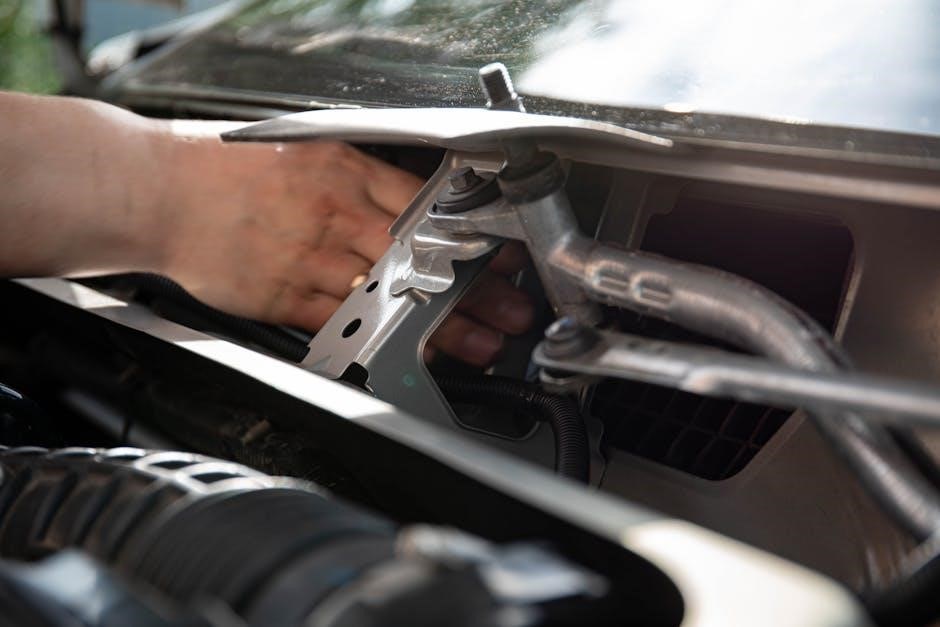
manual wiper
Manual Wiper Systems: An Overview
Manual wiper systems offer a basic‚ reliable method for clearing windshields. They rely on direct human power to move the wiper blades and provide visibility. These systems are simple in design and operation.
What is a Manual Wiper System?
A manual wiper system is a type of windshield clearing mechanism that requires the operator to physically move the wiper blades. It does not rely on an electric motor or any automated components. Instead‚ a hand-operated lever or crank is used to activate a mechanical linkage. This linkage translates the manual input into a sweeping motion across the windshield. Manual systems are often found in older vehicles‚ off-road equipment‚ or small utility vehicles where simplicity and reliability are prioritized over automated convenience. They provide a direct and dependable solution for maintaining visibility in adverse weather conditions.

Components of a Manual Wiper System
Manual wiper systems consist of essential parts working together. These include wiper arms‚ wiper blades‚ and a linkage. These components ensure clear visibility by removing moisture and debris from the windshield during operation;
Wiper Arms
Wiper arms are crucial components connecting the wiper motor to the wiper blades‚ facilitating motion transfer. They are typically attached to the wiper linkage with pivoting joints‚ ensuring proper blade movement. The arms hold the wiper blades firmly against the windshield. This ensures effective clearing of rain‚ snow‚ and debris. Proper torque is important when reattaching the arms. Consult the vehicle’s service manual for torque specifications. The arms must withstand constant use in harsh conditions. Durability and robust construction are‚ therefore‚ vital for reliability and long-term performance‚ ensuring driver visibility.
Wiper Blades
Wiper blades are the direct interface between the wiper system and the windshield‚ critical for clear visibility. Designed to sweep across the surface‚ they remove moisture and debris effectively. These blades consist of a rubber or silicone wiping edge. They are supported by a metal or plastic frame. The material is chosen for flexibility and durability. Regular replacement is essential to maintain optimal performance. Factors like climate and usage affect the lifespan of the blades. Inspecting for wear‚ cracks‚ and streaks will ensure the blades perform their function‚ providing a clear view of the road.
Wiper Linkage
The wiper linkage‚ also known as the wiper transmission or link assembly‚ connects the wiper arms and translates motion. It typically consists of rods‚ pivots‚ and joints working in unison to synchronize the wiper blades’ movement. In manual systems‚ the linkage transfers the operator’s hand motion into a sweeping motion across the windshield. Proper lubrication and maintenance of the linkage are essential for smooth operation and longevity. Wear or damage to any component of the linkage can result in erratic or ineffective wiping. Regular inspection ensures the linkage is free from obstructions and properly aligned.

How a Manual Wiper System Works
Manual wiper systems use a direct mechanical connection. They transmit motion from a hand-operated lever or knob to the wiper blades through a series of linkages. This creates a sweeping action‚ clearing the windshield.
Mechanical Linkage Operation
The mechanical linkage in a manual wiper system translates the rotational motion of a hand crank or lever into the back-and-forth movement of the wiper arms across the windshield. This linkage typically consists of a series of rods‚ pivots‚ and joints that are interconnected.
When the operator moves the lever‚ the motion is transferred through the linkage‚ causing the wiper arms to swing in a synchronized manner. The design ensures the blades maintain contact with the windshield surface‚ effectively clearing rain‚ snow‚ or debris to provide clear visibility. The efficiency of the linkage determines the wiping performance.
Advantages of Manual Wiper Systems
Manual wiper systems offer simplicity in design‚ ensuring reliable operation without dependence on electrical components. They are cost-effective and easy to maintain‚ making them suitable for various applications where simplicity is key.
Simplicity and Reliability
Manual wiper systems stand out due to their straightforward design‚ which inherently leads to greater reliability. With fewer components compared to electric systems‚ there is less risk of mechanical or electrical failure. This simplicity translates to ease of maintenance and repair‚ often requiring only basic tools and skills. The absence of complex wiring and motors eliminates potential points of failure‚ ensuring consistent operation. Their robust nature makes them ideal for environments where durability and dependability are paramount‚ offering a practical solution where advanced features are unnecessary and reliable performance is crucial.
Disadvantages of Manual Wiper Systems
Manual wiper systems require the operator to exert physical effort to maintain clear visibility. This can be tiring over extended periods or during heavy precipitation. It also requires one hand to be constantly operating the wipers.
Manual Effort Required
The primary drawback of manual wiper systems is the need for continuous physical exertion. Unlike electric systems‚ these require the driver or operator to manually move the wipers back and forth. This can be particularly cumbersome during prolonged periods of rain or snow‚ diverting attention from driving;
The repetitive motion can lead to fatigue‚ especially on longer journeys‚ reducing overall driving comfort and potentially impacting reaction times. Operating manual wipers also occupies one hand‚ which could be needed for other vehicle controls. This limitation makes it a less convenient option.
Applications of Manual Wiper Systems
Manual wiper systems are commonly found in applications where simplicity and reliability are key. These include off-road vehicles‚ small utility vehicles‚ and older models where electrical systems may be limited or absent.
Off-Road Vehicles
Off-road vehicles often utilize manual wiper systems due to their durability and resistance to electrical failures. In challenging environments‚ the simplicity of a manual system becomes an advantage. Mud‚ water‚ and rough terrain can compromise electrical components‚ but a manual wiper continues to function.
These systems are commonly found in older jeeps‚ military vehicles‚ and specialized off-road equipment where reliability outweighs convenience. The driver maintains direct control over the wiper speed and operation‚ making it ideal for unpredictable weather and ensuring clear visibility when needed.
Small Utility Vehicles
Manual wiper systems are often used in small utility vehicles such as golf carts and small tractors. These vehicles benefit from the simplicity and cost-effectiveness of manual wipers. Since these vehicles are often used in fair weather‚ they are used in specific locations and situations‚ manual wipers offer an affordable solution for maintaining visibility during light rain or splashes.
The ease of maintenance and lack of electrical components also make them suitable for these applications. Manual wipers provide a practical and reliable option for basic windshield clearing needs in utility vehicles.
Maintenance of Manual Wiper Systems
Maintaining manual wiper systems involves regular inspections of the wiper blades and ensuring smooth linkage operation. Lubricating the moving parts can prevent sticking and extend the lifespan of the system and its components.
Checking Wiper Blade Condition
Regularly inspect the wiper blades for signs of wear and tear‚ such as cracks‚ tears‚ or hardening. Examine the rubber edge that contacts the windshield. Look for uneven wear or damage‚ which can reduce the blade’s effectiveness. Streaking or skipping during operation indicates that the blades need replacement. Clean the blades with a damp cloth to remove dirt and debris‚ ensuring optimal contact with the windshield. Replace the blades every six to twelve months‚ or sooner if performance declines. Proper maintenance ensures clear visibility in adverse weather conditions‚ improving driving safety.
Lubricating Linkage Components
Proper lubrication of the manual wiper system’s linkage is crucial for smooth and efficient operation. Apply a small amount of lubricant‚ such as white lithium grease‚ to all moving joints and pivot points within the linkage. This reduces friction‚ preventing sticking and binding. Regular lubrication ensures the components move freely‚ maximizing the effectiveness of the wiper system. Clean the linkage before applying lubricant to remove any dirt or debris. Repeat this process every few months‚ or more frequently in harsh conditions‚ to maintain optimal performance and extend the lifespan of the system.

Troubleshooting Common Issues
Manual wiper systems can experience problems. These can include sticking wiper arms or worn wiper blades. Regular inspection and simple maintenance steps can address these issues and restore clear visibility.
Sticking Wiper Arms
Sticking wiper arms are a frequent problem with manual systems. This occurs due to rust or lack of lubrication. The arm’s pivot points become stiff‚ hindering free movement. Applying penetrating oil to the joints helps loosen the corrosion. Gently work the arm back and forth to distribute the lubricant. For severe cases‚ disassembly and cleaning may be necessary. Ensure all parts are well-lubricated before reassembling. Regular lubrication prevents future sticking. Check the arm’s physical condition for bends or damage. Replace if necessary to ensure smooth and effective operation. A smooth operation is key to clear visibility.
Worn Wiper Blades
Worn wiper blades are a common issue affecting visibility. Streaking‚ skipping‚ or smearing indicate blade deterioration. Sunlight‚ debris‚ and age degrade the rubber compound. Inspect the blades for cracks‚ tears‚ or uneven wear. Clean the blades regularly with a damp cloth to remove debris. Replace blades every six months to a year‚ depending on use. Choose high-quality replacement blades for optimal performance. Ensure the new blades are the correct size and type for the wiper arms. Properly installed blades guarantee clear visibility. Regular checks and timely replacements maintain safe driving conditions. Consider silicone blades for extended lifespan.
Converting from Manual to Electric Wipers
Upgrading from manual to electric wipers enhances convenience and efficiency. This conversion involves replacing the manual system with an electric motor-driven setup. Electric wipers provide consistent‚ hands-free operation‚ improving visibility during inclement weather.
Components Required for Conversion
Converting from a manual to an electric wiper system requires several key components. An electric wiper motor provides the necessary power. A wiring harness connects the motor to the vehicle’s electrical system.
A wiper switch allows the driver to control the wipers. Linkage connects the motor to the wiper arms. New wiper arms and blades may be required for compatibility. A fuse protects the circuit from overloads. Mounting brackets secure the motor and linkage.
Detailed installation instructions ensure proper setup. These components work together for a reliable electric wiper system.

Safety Considerations
Safety with manual wipers depends on clear visibility. Maintain wiper components for effective clearing. Use wipers in adverse conditions. Ensure proper function before driving. Regular checks are crucial.
Ensuring Clear Visibility
Maintaining clear visibility is paramount when using manual wiper systems. Proper function of the wiper blades directly impacts the driver’s ability to see the road and react to hazards. Regularly inspect wiper blades for wear and tear‚ replacing them when streaking or smearing occurs. Before driving‚ ensure the windshield is clean to reduce friction and optimize wiper effectiveness. Adjust wiper arm tension for consistent blade contact. During inclement weather‚ operate the manual wipers at a suitable pace to clear the windshield adequately. Use caution and reduce speed when visibility is compromised‚ relying on the wipers to provide a safe field of view.
Related Posts

kenwood dmx7709s manual
Lost your Kenwood DMX7709S manual? Find a free, easy-to-use PDF guide here! Unlock all the features of your car stereo & hit the road happy. #Kenwood

neo g8 manual
Need help with your Neo G8? Find the official manual here! Troubleshooting, features, and everything you need for a smooth experience. Download your **Neo G8 manual** now!

ww scale manual
Need a WW scale manual? Quickly find instructions for any model at ShowLosAngeles! Download PDFs & troubleshoot issues – get weighing accurately now. #WWScale